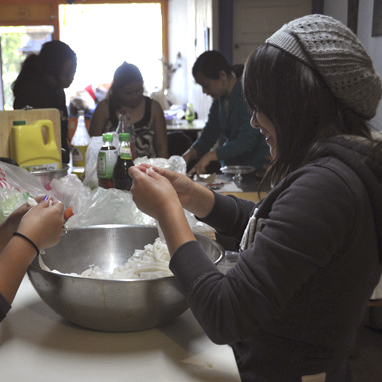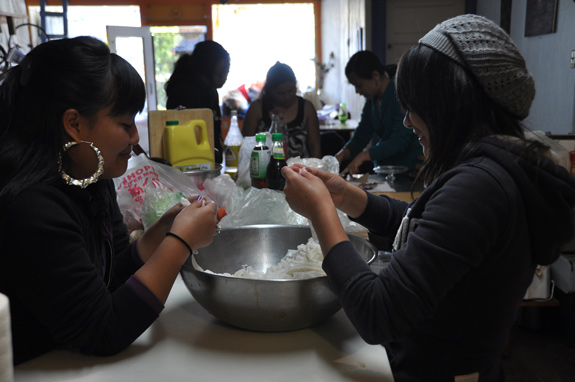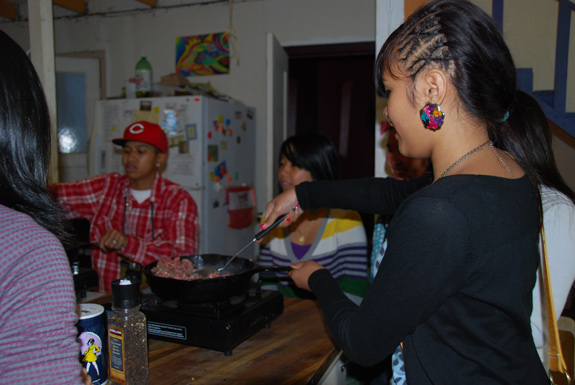Who Wants to Grate the Ginger?: Food as Intervention

Staff + Alum reflect on 2013
October 31, 2013
Polishing brighter beauties in Oakland’s fight against child sex trafficking
December 26, 2013
Recently, an inspiring elder, whom we will call “Ming” to protect her privacy, shared with us her childhood experiences during the Khmer Rouge reign in Cambodia. At the age of six, she was separated from her family and put into a child labor camp; her father was sent to a separate camp for men. In the child labor camp, Ming worked long hours but received only a tiny portion of rice for the day. Eventually, her body weakened from hunger and she became ill, but the Khmer Rouge soldiers would not allow her to return to her mother’s village until her illness became critical. Finally, the soldiers sent her home to her mother. With her mother’s love and the support of the village medicine man, Ming recovered, but shortly after, the soldiers came looking for her and sent her back to the child labor camp. Back at the labor camp, Ming befriended another young girl. Late one night, the soldiers came to get Ming’s friend. She never returned and Ming never saw her again. She only heard rumors that her friend had been killed.

Food preparation is followed by a shared meal and storytelling sessions, where both the community elders and young women are encouraged to share. Photo: Amy Kitchener
Cooking, storytelling, and sharing a meal give us, the Southeast Asian community, a breath, a moment, an opportunity to heal ourselves and each other, together. No one is judged for her decisions or actions. As Ming told her story to the young women and Banteay Srei staff, feelings of compassion and a connection to each other filled the room. At some moments of the story they shared tears, and other times they chuckled, or sat in silence.
Southeast Asian Unity through Cultural Exploration, or SAUCE, is a culinary program of Banteay Srei, where young Cambodian, Chinese-Vietnamese, Iu-Mien, Khmu, Lao and Vietnamese women involved in or at risk of sexual exploitation and their matriarchal elders connect through the art of collectively cooking traditional Southeast Asian foods and oral history. Gathering over cooking and eating delicious food provides a safe and neutral place for multiple generations to come together, break bread, and move forward together. The young women are second- and third-generation Southeast Asian Americans overcoming physical, verbal, sexual violence, while dealing with additional everyday risks, all the while engulfed in school. The program allows them to unite with and heal with their mothers or elders, who themselves are first- and 1.5 generation immigrants and refugees of the Vietnam War in Southeast Asia, busy working multiple jobs to provide financial support for the family, or struggling with their own trauma and not being available for their children.
Between 3:50-4:15pm, the young women slowly trickle in to the kitchen. Some arrive with a calm, collected energy, while others are excited about what happened at school that day and are eager to share. Either way, they are greeted with “How was your day today?” and are embraced by the staff. In a matter of minutes, the kitchen quickly goes from cold and quiet, to filled with warmth, laughter, stories, and love. The young women know the first thing to do is to immediately wash their hands before handling anything in the kitchen, and then they are ready.Nowadays, Southeast Asian immigrant families in California rarely have the opportunity to eat with each other. SAUCE provides a safe and warm space where young Southeast Asian women and their mothers or elders are able to slow down from everyday life. Southeast Asian matriarchal elders are invited to demonstrate and prepare traditional recipes such as Ka Soy (Iu-Mien noodle soup), Banh Xeo (Vietnamese savory fried pancakes), Chicken Larb (Lao minced meat salad), and many other culinary dishes from Cambodia, Laos and Vietnam. At Banteay Srei’s SAUCE program, the young women learn how to properly handle and prepare food, cooking techniques, and how to use kitchen tools, while gaining knowledge about cultural food and overlaps in different Southeast Asian dishes, and about each other. But more importantly, they are building a space to create peer-and intergenerational-support.

SAUCE provides a neutral space where, through traditional food preparation and storytelling, intergenerational healing and connection takes place. Photo courtesy of Banteay Srei
A recent gathering featured the preparation of a Roast Salmon with a Ginger Soy Sauce Glaze. Once the young women had an opportunity to release their energy, engage with each other and settle down, Saengthip, the Banteay Srei’s SAUCE apprentice, lays out the ingredients onto the kitchen island and introduces them–salmon, olive oil, ginger, garlic, Dijon mustard, chili paste, brown sugar, soy sauce and dill. In order to divide the responsibilities, Saengthip first asks who is interested in doing what. “Alright, who wants to grate the ginger? Mince the garlic? Pick the dill off its stems?” Most of the young women are quick to volunteer what they are interested in doing, while a couple of stragglers are more interested in observing. After all the ingredients are prepared, some volunteers begin to clean up, while another slowly rubs olive oil onto the salmon, places it on a baking pan and into the oven for twenty minutes. While the salmon cooks, some of the young women hover over the kitchen island to put together the glaze. Reacting to the aroma of the ginger, garlic, chili paste and soy sauce, one of the participants blurts out appreciatively, “Mmmm, smells hella good, I love the smell of fresh garlic.” The delicious smell of the salmon fills the air, providing the atmosphere with the comfort and warmth of anticipating a meal that will fill empty stomachs. Some participants stick around the oven to stay warm, while other youth laugh, sing, and continue telling stories. As the salmon comes out of the oven, the glaze is spread onto the fish. Finally, before serving, the salmon is garnished with dill. This is the first time that the participants have ever tried dill; it turns out that they love it so much they keep asking for more. After preparing the food, the table is set and everyone gathers around to enjoy the meal together.
In other SAUCE sessions, young women are encouraged to ask their parents, aunts, uncles or elders for a family recipe to share. It is significant for our youth to engage and be rooted in their cultural values and have a sense of guidance from our elders. At the dinner table, the elders practice oral history by sharing their stories and experience living and running from their war torn countries — Cambodia, Laos, and Vietnam. They share the struggles they faced resettling in the United States while raising a family and maintaining their cultures with very little resources.
Modeled after the elders’ cooking and storytelling, the young women are given individual time to share their recipe, cook, and also tell their story of hopes, obstacles and dreams. “Developing a support system amongst the young women, staff, and elders at SAUCE is important to me,” explained one of the SAUCE young women. Young women of SAUCE value the honesty, companionship, and bonding that happen at SAUCE, especially when they feel isolated on the streets, school and even at home. It is a powerful program that provides artistic outlets and life skills for women who are seeking ways to become empowered and connect with their roots. One of our SAUCE participants expressed, “I love learning about my culture and history. Makes me know more about parents and even myself. I love the bond with my SAUCE sisters.”
To say that food is sustaining and life-giving is to state the obvious. Through multiple Living Cultures Grants, ACTA has encouraged the wisdom of reaching the heart through the stomach by supporting the fine work of Banteay Srei, an Oakland-based group of case managers, health educators, and social workers who provide culturally competent services to young Southeast Asian women who are impacted by the sex trade. Discerning healthy choices can be confusing for the program’s participants (ages 14-19), who are vulnerable to fetishization of Southeast Asians as sex objects, coupled with the lure of a relationship that promises comfort but turns into exploitation.
ALLIANCE FOR CALIFORNIA TRADITIONAL ARTS
Sharing the fragrant smells of traditional dishes along with storytelling can build bridges between American-raised children of immigrants and older generations who may have found the acculturation process challenging and possibly traumatic. This is an intervention based on traditional arts. It is in the model of a family meal, designed to provide nurturance in the truest concept of the word, both physically and emotionally.
Our guest writers are on the front lines, providing a non-judgmental environment for young women and empowering them with the knowledge that “…every person is entitled to living a free, happy, and healthy life that is full of options.” Program director Nkauj Iab Yang is a Hmong-American who trains and supports the development of the Southeast Asian Unity through Cultural Exploration (SAUCE) apprentices in culinary practices, food justice, and exploring healthy alternatives. Co-author Saengthip Keosaeng, Khmu-American, has been a Banteay Srei’s SAUCE apprentice and currently works in a leadership capacity interfacing with youth in the community through outreach programs to schools. She describes herself as “passionate about delicious food, youth development, and youth justice.”
~ Lily Kharrazi, Living Cultures Grants Program Manager



